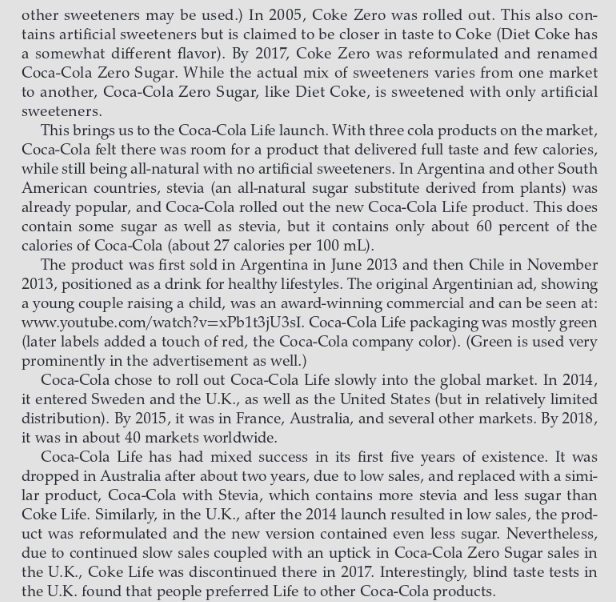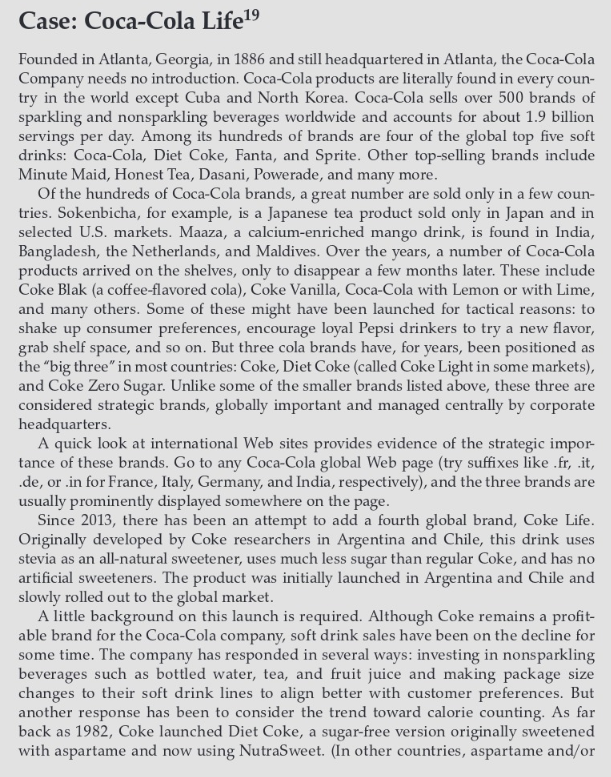What are the pros and cons of adding this product to the “big three” strategic cola brands, effectively creating a “big four” in some markets?
What are the pros and cons of adding this product to the “big three” strategic cola brands, effectively creating a “big four” in some markets?
Principles Of Marketing
17th Edition
ISBN:9780134492513
Author:Kotler, Philip, Armstrong, Gary (gary M.)
Publisher:Kotler, Philip, Armstrong, Gary (gary M.)
Chapter1: Marketing: Creating Customer Value And Engagement
Section: Chapter Questions
Problem 1.1DQ
Related questions
Question
100%
What are the pros and cons of adding this product to the “big three” strategic cola brands, effectively creating a “big four” in some markets?

Transcribed Image Text:other sweeteners may be used.) In 2005, Coke Zero was rolled out. This also con-
tains artificial sweeteners but is claimed to be closer in taste to Coke (Diet Coke has
a somewhat different flavor). By 2017, Coke Zero was reformulated and renamed
Coca-Cola Zero Sugar. While the actual mix of sweeteners varies from one market
to another, Coca-Cola Zero Sugar, like Diet Coke, is sweetened with only artificial
sweeteners.
This brings us to the Coca-Cola Life launch. With three cola products on the market,
Coca-Cola felt there was room for a product that delivered full taste and few calories,
while still being all-natural with no artificial sweeteners. In Argentina and other South
American countries, stevia (an all-natural sugar substitute derived from plants) was
already popular, and Coca-Cola rolled out the new Coca-Cola Life product. This does
contain some sugar as well as stevia, but it contains only about 60 percent of the
calories of Coca-Cola (about 27 calories per 100 mL).
The product was first sold in Argentina in June 2013 and then Chile in November
2013, positioned as a drink for healthy lifestyles. The original Argentinian ad, showing
a young couple raising a child, was an award-winning commercial and can be seen at:
www.youtube.com/watch?v=xPb1t3jU3sI. Coca-Cola Life packaging was mostly green
(later labels added a touch of red, the Coca-Cola company color). (Green is used very
prominently in the advertisement as well.)
Coca-Cola chose to roll out Coca-Cola Life slowly into the global market. In 2014,
it entered Sweden and the U.K., as well as the United States (but in relatively limited
distribution). By 2015, it was in France, Australia, and several other markets. By 2018,
it was in about 40 markets worldwide.
Coca-Cola Life has had mixed success in its first five years of existence. It was
dropped in Australia after about two years, due to low sales, and replaced with a simi-
lar product, Coca-Cola with Stevia, which contains more stevia and less sugar than
Coke Life. Similarly, in the U.K., after the 2014 launch resulted in low sales, the prod-
uct was reformulated and the new version contained even less sugar. Nevertheless,
due to continued slow sales coupled with an uptick in Coca-Cola Zero Sugar sales in
the U.K., Coke Life was discontinued there in 2017. Interestingly, blind taste tests in
the U.K. found that people preferred Life to other Coca-Cola products.

Transcribed Image Text:Case: Coca-Cola Life¹⁹
Founded in Atlanta, Georgia, in 1886 and still headquartered in Atlanta, the Coca-Cola
Company needs no introduction. Coca-Cola products are literally found in every coun-
try in the world except Cuba and North Korea. Coca-Cola sells over 500 brands of
sparkling and nonsparkling beverages worldwide and accounts for about 1.9 billion
servings per day. Among its hundreds of brands are four of the global top five soft
drinks: Coca-Cola, Diet Coke, Fanta, and Sprite. Other top-selling brands include
Minute Maid, Honest Tea, Dasani, Powerade, and many more.
Of the hundreds of Coca-Cola brands, a great number are sold only in a few coun-
tries. Sokenbicha, for example, is a Japanese tea product sold only in Japan and in
selected U.S. markets. Maaza, a calcium-enriched mango drink, is found in India,
Bangladesh, the Netherlands, and Maldives. Over the years, a number of Coca-Cola
products arrived on the shelves, only to disappear a few months later. These include
Coke Blak (a coffee-flavored cola), Coke Vanilla, Coca-Cola with Lemon or with Lime,
and many others. Some of these might have been launched for tactical reasons: to
shake up consumer preferences, encourage loyal Pepsi drinkers to try a new flavor,
grab shelf space, and so on. But three cola brands have, for years, been positioned as
the "big three" in most countries: Coke, Diet Coke (called Coke Light in some markets),
and Coke Zero Sugar. Unlike some of the smaller brands listed above, these three are
considered strategic brands, globally important and managed centrally by corporate
headquarters.
A quick look at international Web sites provides evidence of the strategic impor-
tance of these brands. Go to any Coca-Cola global Web page (try suffixes like .fr, .it,
.de, or .in for France, Italy, Germany, and India, respectively), and the three brands are
usually prominently displayed somewhere on the page.
Since 2013, there has been an attempt to add a fourth global brand, Coke Life.
Originally developed by Coke researchers in Argentina and Chile, this drink uses
stevia as an all-natural sweetener, uses much less sugar than regular Coke, and has no
artificial sweeteners. The product was initially launched in Argentina and Chile and
slowly rolled out to the global market.
A little background on this launch is required. Although Coke remains a profit-
able brand for the Coca-Cola company, soft drink sales have been on the decline for
some time. The company has responded in several ways: investing in nonsparkling
beverages such as bottled water, tea, and fruit juice and making package size
changes to their soft drink lines to align better with customer preferences. But
another response has been to consider the trend toward calorie counting. As far
back as 1982, Coke launched Diet Coke, a sugar-free version originally sweetened
with aspartame and now using NutraSweet. (In other countries, aspartame and/or
Expert Solution
This question has been solved!
Explore an expertly crafted, step-by-step solution for a thorough understanding of key concepts.
This is a popular solution!
Trending now
This is a popular solution!
Step by step
Solved in 2 steps

Recommended textbooks for you

Principles Of Marketing
Marketing
ISBN:
9780134492513
Author:
Kotler, Philip, Armstrong, Gary (gary M.)
Publisher:
Pearson Higher Education,

Marketing
Marketing
ISBN:
9781259924040
Author:
Roger A. Kerin, Steven W. Hartley
Publisher:
McGraw-Hill Education

Foundations of Business (MindTap Course List)
Marketing
ISBN:
9781337386920
Author:
William M. Pride, Robert J. Hughes, Jack R. Kapoor
Publisher:
Cengage Learning

Principles Of Marketing
Marketing
ISBN:
9780134492513
Author:
Kotler, Philip, Armstrong, Gary (gary M.)
Publisher:
Pearson Higher Education,

Marketing
Marketing
ISBN:
9781259924040
Author:
Roger A. Kerin, Steven W. Hartley
Publisher:
McGraw-Hill Education

Foundations of Business (MindTap Course List)
Marketing
ISBN:
9781337386920
Author:
William M. Pride, Robert J. Hughes, Jack R. Kapoor
Publisher:
Cengage Learning

Marketing: An Introduction (13th Edition)
Marketing
ISBN:
9780134149530
Author:
Gary Armstrong, Philip Kotler
Publisher:
PEARSON


Contemporary Marketing
Marketing
ISBN:
9780357033777
Author:
Louis E. Boone, David L. Kurtz
Publisher:
Cengage Learning